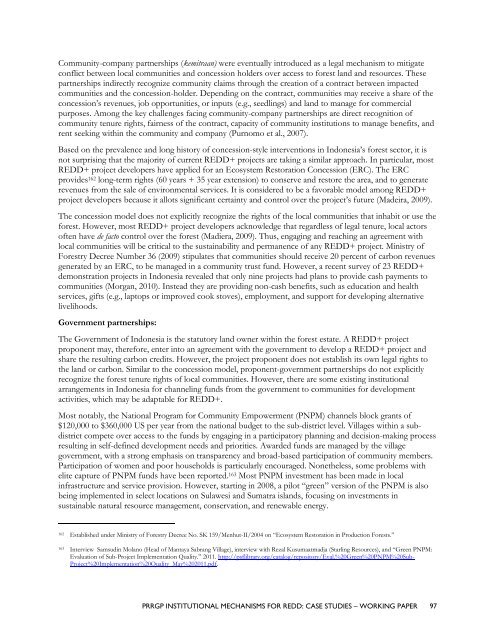Institutional Mechanisms for REDD+ - Case Studies Working Paper
Institutional Mechanisms for REDD+ - Case Studies Working Paper
Institutional Mechanisms for REDD+ - Case Studies Working Paper
Create successful ePaper yourself
Turn your PDF publications into a flip-book with our unique Google optimized e-Paper software.
Community-company partnerships (kemitraan) were eventually introduced as a legal mechanism to mitigate<br />
conflict between local communities and concession holders over access to <strong>for</strong>est land and resources. These<br />
partnerships indirectly recognize community claims through the creation of a contract between impacted<br />
communities and the concession-holder. Depending on the contract, communities may receive a share of the<br />
concession‘s revenues, job opportunities, or inputs (e.g., seedlings) and land to manage <strong>for</strong> commercial<br />
purposes. Among the key challenges facing community-company partnerships are direct recognition of<br />
community tenure rights, fairness of the contract, capacity of community institutions to manage benefits, and<br />
rent seeking within the community and company (Purnomo et al., 2007).<br />
Based on the prevalence and long history of concession-style interventions in Indonesia‘s <strong>for</strong>est sector, it is<br />
not surprising that the majority of current <strong>REDD+</strong> projects are taking a similar approach. In particular, most<br />
<strong>REDD+</strong> project developers have applied <strong>for</strong> an Ecosystem Restoration Concession (ERC). The ERC<br />
provides 162 long-term rights (60 years + 35 year extension) to conserve and restore the area, and to generate<br />
revenues from the sale of environmental services. It is considered to be a favorable model among <strong>REDD+</strong><br />
project developers because it allots significant certainty and control over the project‘s future (Madeira, 2009).<br />
The concession model does not explicitly recognize the rights of the local communities that inhabit or use the<br />
<strong>for</strong>est. However, most <strong>REDD+</strong> project developers acknowledge that regardless of legal tenure, local actors<br />
often have de facto control over the <strong>for</strong>est (Madiera, 2009). Thus, engaging and reaching an agreement with<br />
local communities will be critical to the sustainability and permanence of any <strong>REDD+</strong> project. Ministry of<br />
Forestry Decree Number 36 (2009) stipulates that communities should receive 20 percent of carbon revenues<br />
generated by an ERC, to be managed in a community trust fund. However, a recent survey of 23 <strong>REDD+</strong><br />
demonstration projects in Indonesia revealed that only nine projects had plans to provide cash payments to<br />
communities (Morgan, 2010). Instead they are providing non-cash benefits, such as education and health<br />
services, gifts (e.g., laptops or improved cook stoves), employment, and support <strong>for</strong> developing alternative<br />
livelihoods.<br />
Government partnerships:<br />
The Government of Indonesia is the statutory land owner within the <strong>for</strong>est estate. A <strong>REDD+</strong> project<br />
proponent may, there<strong>for</strong>e, enter into an agreement with the government to develop a <strong>REDD+</strong> project and<br />
share the resulting carbon credits. However, the project proponent does not establish its own legal rights to<br />
the land or carbon. Similar to the concession model, proponent-government partnerships do not explicitly<br />
recognize the <strong>for</strong>est tenure rights of local communities. However, there are some existing institutional<br />
arrangements in Indonesia <strong>for</strong> channeling funds from the government to communities <strong>for</strong> development<br />
activities, which may be adaptable <strong>for</strong> <strong>REDD+</strong>.<br />
Most notably, the National Program <strong>for</strong> Community Empowerment (PNPM) channels block grants of<br />
$120,000 to $360,000 US per year from the national budget to the sub-district level. Villages within a subdistrict<br />
compete over access to the funds by engaging in a participatory planning and decision-making process<br />
resulting in self-defined development needs and priorities. Awarded funds are managed by the village<br />
government, with a strong emphasis on transparency and broad-based participation of community members.<br />
Participation of women and poor households is particularly encouraged. Nonetheless, some problems with<br />
elite capture of PNPM funds have been reported. 163 Most PNPM investment has been made in local<br />
infrastructure and service provision. However, starting in 2008, a pilot ―green‖ version of the PNPM is also<br />
being implemented in select locations on Sulawesi and Sumatra islands, focusing on investments in<br />
sustainable natural resource management, conservation, and renewable energy.<br />
162 Established under Ministry of Forestry Decree No. SK 159/Menhut-II/2004 on ―Ecosystem Restoration in Production Forests.‖<br />
163 Interview Samsudin Molano (Head of Mantaya Sabrang Village), interview with Rezal Kusumaatmadja (Starling Resources), and ―Green PNPM:<br />
Evaluation of Sub-Project Implementation Quality.‖ 2011. http://psflibrary.org/catalog/repository/Eval.%20Green%20PNPM%20Sub-<br />
Project%20Implementation%20Quality_May%202011.pdf.<br />
PRRGP INSTITUTIONAL MECHANISMS FOR REDD: CASE STUDIES – WORKING PAPER 97

















